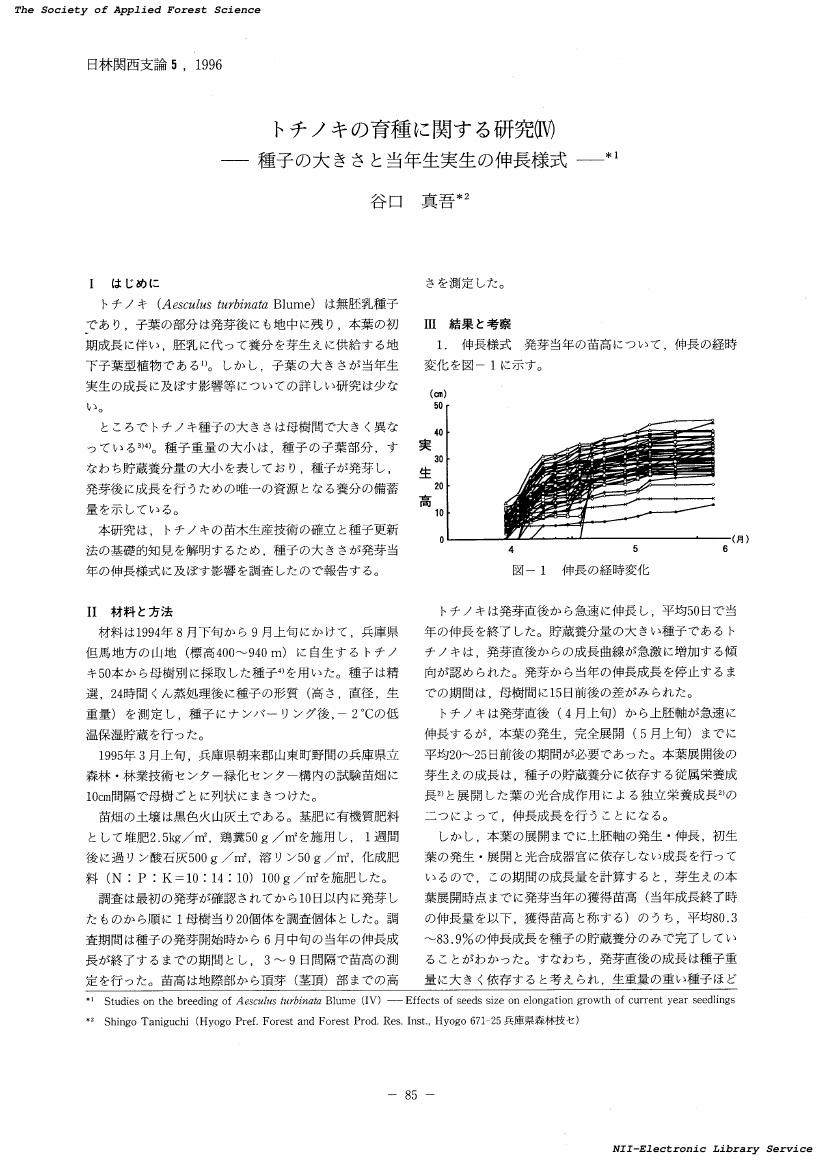1 0 0 0 OA 林齢の増加に伴うスギ林花粉生産量の変化
- 著者
- 内舘 光邦 齋藤 秀樹 竹岡 政治
- 出版者
- 応用森林学会
- 雑誌
- 日本林学会関西支部論文集 (ISSN:09182268)
- 巻号頁・発行日
- vol.1, pp.215-218, 1992-05-31 (Released:2018-01-23)
In order to determine changes in the annual production of pollen by Sugi (Cryptomeria Japonica D. Don) stands with increasing age, five stands ranging in age from a planted 37-yr-old stand to one about 600 yr old in the grounds of a Buddhist temple were studied. Pollen production rates were estimated from the number of fallen male flowers in a stand by the litter trap method and the quantity of pollen per flower sampled before anthesis. The relationship between the number of fallen male flowers in a atand and stand age showed a ceiling curve, indicating a constant upper limit for several hundred years after the age of 50 yr. This minimum stand age of 50 yr, after which a constant value of pollen was produced, was quoted from findings obtained in our previous study. The data indicate that an increase of pollen dispersal per unit land area if the final cutting age of Sugi forests is increased to as much as 120-150 yr is improbable. In 1990, the production rate in the five study stands was estimated to be 4.3-52×10^<12> pollen grains ha-<-1>yr^<-1>, or 43-360kg d. w. ha^<-1> yr^<-1>,
1 0 0 0 OA トチノキの育種に関する研究(IV) : 種子の大きさと当年生実生の伸長様式(育種)
- 著者
- 谷口 真吾
- 出版者
- 応用森林学会
- 雑誌
- 日本林学会関西支部論文集 (ISSN:09182268)
- 巻号頁・発行日
- vol.5, pp.85-88, 1996-03-25 (Released:2018-01-23)
1 0 0 0 OA 同齢人工林の上層樹高-本数曲線の検討
- 著者
- 稲田 充男
- 出版者
- 応用森林学会
- 雑誌
- 日本林学会関西支部論文集 (ISSN:09182268)
- 巻号頁・発行日
- vol.1, pp.61-64, 1992-05-31 (Released:2018-01-23)
1 0 0 0 OA マツノマダラカミキリの簡易な人工飼料飼育法(保護)
- 著者
- 上田 明良 遠田 暢男
- 出版者
- 応用森林学会
- 雑誌
- 日本林学会関西支部論文集 (ISSN:09182268)
- 巻号頁・発行日
- vol.5, pp.143-144, 1996-03-25 (Released:2018-01-23)
A simple method of rearing of the Japanese pine sawyer, Monochamus alternatus Hope (Coleoptera: Cerambycidae) on an artificial diet is proposed. The diet is composed of a commercially available artificial diet used for the silkworm, Bombix mori (Silkmate 3M(R); Nippon Nosan Kogyo Co.), milled fresh inner bark of Japanese red pine, dried yeast and tap water. The masses of each ingredient required for 150 beetles (=150 rearing bottles) are 2kg, 1kg, 20g and 1500ml, respectively. The bottles were autoclaved for 10 min. (1.2kg/cm^2, 120℃). In the case of inoculated first and second instar larvae from Kyoto and Ibaraki, Japan, these were reared at 25℃LD10:14 for five months after oviposition, chilled for two months at 10℃ constant darkness and then reared at 25℃LD16:8. One hundred and seventy five beetles from 210 inoculated larvae (84.8%) emerged an average 47.2 days after chilling.
1 0 0 0 OA 梅雨マツタケ(サマツ)の発生要因について
- 著者
- 川上 嘉章
- 出版者
- 応用森林学会
- 雑誌
- 日本林学会関西支部論文集 (ISSN:09182268)
- 巻号頁・発行日
- no.1, pp.101-102, 1992-05-31


